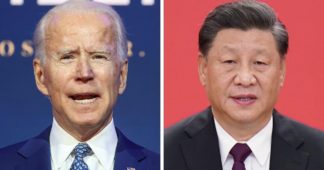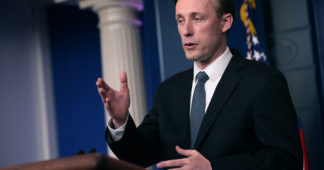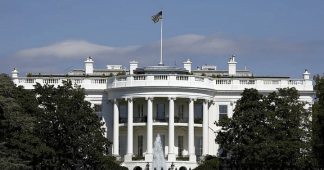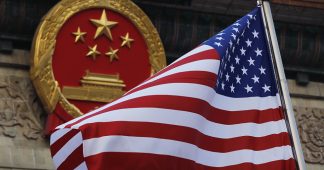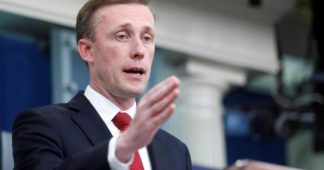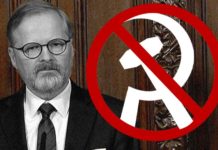By Özgür Altınbaş
Aug 5, 2023
U.S. National Security Advisor Jake Sullivan made a statement full of confessions about the US economy. Stating that the economy can no longer be saved with the existing system, Sullivan called for increasing public investments. The US official also underlined that the American middle class is losing ground.
The leaders of the system in the U.S. themselves openly criticize neoliberalism now. Jake Sullivan has voiced the need for a new system in the US, where banks are failing and inflation is rising. In a speech held in the Brookings Institute on “Renewing American economic leadership”, Sullivan stated that the changing global economy had left behind lots of working Americans.
‘Privatization as an end in itself’
Sullivan concluded that the vision of public investment that had energized the post-war American project has weakened. Sullivan said “The vision of public investment that had energized the American project in the postwar years—and indeed for much of our history—had faded. It had given way to a set of ideas that championed tax cutting and deregulation, privatization over public action, and trade liberalization as an end in itself.”
Sullivan stated that all policies are based on a single assumption: “There was one assumption at the heart of all of this policy: that markets always allocate capital productively and efficiently.” Emphasizing that the shocks caused by the global financial crisis and a global pandemic have revealed the limits of these prevailing assumptions, Sullivan added “in the name of oversimplified market efficiency, entire supply chains of strategic goods—along with the industries and jobs that made them—moved overseas.” Sullivan also highlighted that the assumption that broad trade liberalization would help America export goods, not jobs and capacity, was “a promise made but not kept”
‘China subsidized while we lose manufacturing’
Sullivan, who referred to China a lot in his speech, drew attention to China’s public-sector-oriented policy. “America didn’t just lose manufacturing – we eroded our competitiveness in critical technologies that would define the future,” admitted Sullivan, who said that Beijing subsidizes both traditional industrial sectors such as steel and key sectors of the future such as clean energy, digital infrastructure and advanced biotechnologies on a large scale.
‘We ignored the economic interdependencies during decades of liberalization’
Sullivan said they ignored the economic interdependencies built up over decades of liberalisation. He emphasised this created real dangers, from uncertainty about energy in Europe to supply chain gaps in medical equipment, semiconductors and critical minerals. These dependencies, Sullivan said, are the kind of dependencies that can be used as economic or geopolitical leverages.
‘The rich got richer, the middle class lost ground’
Sullivan also said that the prevailing assumption that trade-based growth will be inclusive turned out to be unrealistic. He stated that the approach, according to which benefits from international trade would be distributed widely among nations actually led to a situation where no working person benefits. “The American middle class lost ground while the wealthy did better than ever. And American manufacturing communities were hollowed out while cutting-edge industries moved to metropolitan areas”, Sullivan said
The need of investment in strategic sectors
Sullivan stressed the need for a new foundation of the modern American industrial strategy as a solution to the crisis. In this context, he said: “A modern American industrial strategy identifies specific sectors that are foundational to economic growth, strategic from a national security perspective, and where private industry on its own isn’t poised to make the investments needed to secure our national ambitions… This is about crowding in private investment—not replacing it. It’s about making long-term investments in sectors vital to our national wellbeing.”
Inadequacy of the traditional model
At the end of his speech, Sullivan stated that the listed measures are considered by some as non-traditional. He said this is what the issue is all about: “For the problems we are trying to solve today, the traditional model doesn’t cut it.” Underlying “The era of after-the-fact policy patches and vague promises of redistribution is over”, “We need a new approach” Sullivan concluded.
Some of the highlights of US National Security Advisor Jake Sullivan’s statement are as follows (quotes from his speech)
After the Second World War, the United States led a fragmented world to build a new international economic order. It lifted hundreds of millions of people out of poverty. It sustained thrilling technological revolutions. And it helped the United States and many other nations around the world achieve new levels of prosperity.
But the last few decades revealed cracks in those foundations. A shifting global economy left many working Americans and their communities behind.
A financial crisis shook the middle class. A pandemic exposed the fragility of our supply chains. A changing climate threatened lives and livelihoods. Russia’s invasion of Ukraine underscored the risks of overdependence.
So this moment demands that we forge a new consensus.
That’s why the United States, under President Biden, is pursuing a modern industrial and innovation strategy—both at home and with partners around the world. One that invests in the sources of our own economic and technological strength, that promotes diversified and resilient global supply chains, that sets high standards for everything from labor and the environment to trusted technology and good governance, and that deploys capital to deliver on public goods like climate and health.
Now, the idea that a “new Washington consensus,” as some people have referred to it, is somehow America alone, or America and the West to the exclusion of others, is just flat wrong.
This strategy will build a fairer, more durable global economic order, for the benefit of ourselves and for people everywhere.
So today, what I want to do is lay out what we are endeavoring to do. And I’ll start by defining the challenges as we see them—the challenges that we face. To take them on, we’ve had to revisit some old assumptions. Then I’ll walk through, step by step, how our approach is tailored to meeting those challenges.
When President Biden came into office more than two years ago, the country faced, from our perspective, four fundamental challenges.
First, America’s industrial base had been hollowed out.
Another embedded assumption was that the type of growth did not matter. All growth was good growth. So, various reforms combined and came together to privilege some sectors of the economy, like finance, while other essential sectors, like semiconductors and infrastructure, atrophied. Our industrial capacity—which is crucial to any country’s ability to continue to innovate—took a real hit.
The second challenge we faced was adapting to a new environment defined by geopolitical and security competition, with important economic impacts.
Much of the international economic policy of the last few decades had relied upon the premise that economic integration would make nations more responsible and open, and that the global order would be more peaceful and cooperative—that bringing countries into the rules-based order would incentivize them to adhere to its rules.
It didn’t turn out that way. In some cases it did, and in lot of cases it did not.
By the time President Biden came into office, we had to contend with the reality that a large non-market economy had been integrated into the international economic order in a way that posed considerable challenges.
Economic integration didn’t stop China from expanding its military ambitions in the region, or stop Russia from invading its democratic neighbors. Neither country had become more responsible or cooperative.
The third challenge we faced was an accelerating climate crisis and the urgent need for a just and efficient énergie transition.
When President Biden came into office, we were falling dramatically short of our climate ambitions, without a clear pathway to abundant supplies of stable and affordable clean energy, despite the best efforts of the Obama-Biden Administration to make significant headway.
Too many people believed that we had to choose between economic growth and meeting our climate goals.
President Biden has seen things totally differently. As he’s often said, when he hears “climate,” he thinks “jobs.” He believes that building a twenty-first-century clean-energy economics is one of the most significant growth opportunities of the twenty-first century—but that to harness that opportunity, America needs a deliberate, hands-on investment strategy to pull forward innovation, drive down costs, and create good jobs.
Finally, we faced the challenge of inequality and its damage to democracy.
Now, the drivers of economic inequality—as many of you know even better than I—are complex, and they include structural challenges like the digital revolution. But key among these drivers are decades of trickle-down economic policies—policies like regressive tax cuts, deep cuts to public investment, unchecked corporate concentration, and active measures to undermine the labor movement that initially built the American middle class.
Efforts to take a different approach during the Obama Administration—including efforts to pass policies to address climate change, invest in infrastructure, expand the social safety net, and protect workers’ rights to organize—were stymied by Republican opposition.
And frankly, our domestic economic policies also failed to fully account for the consequences of our international economic policies.
For example, the so-called “China shock” that hit pockets of our domestic manufacturing industry especially hard—with large and long-lasting impacts—wasn’t adequately anticipated and wasn’t adequately addressed as it unfolded.
And collectively, these forces had frayed the socioeconomic foundations on which any strong and resilient democracy rests.
Now, these four challenges were not unique to the United States. Established and emerging economies were confronting them, too—in some cases more acutely than we are.
When President Biden came to office, he knew the solution to each of these challenges was to restore an economic mentality that champions building. And that is the core of our economic approach. To build. To build capacity, to build resilience, to build inclusiveness, at home and with partners abroad. The capacity to produce and innovate, and to deliver public goods like strong physical and digital infrastructure and clean energy at scale. The resilience to withstand natural disasters and geopolitical shocks. And the inclusiveness to ensure a strong, vibrant American middle class and greater opportunity for working people around the world.
All of that is part of what we have called a foreign policy for the middle class.
The first step is laying a new foundation at home—with a modern American industrial strategy.
My friend and former colleague Brian Deese has spoken about this new industrial strategy at some length, and I commend his remarks to you, because they are better than any remarks I could give on the subject. But in summary:
A modern American industrial strategy identifies specific sectors that are foundational to economic growth, strategic from a national security perspective, and where private industry on its own isn’t poised to make the investments needed to secure our national ambitions.
It deploys targeted public investments in these areas that unlock the power and ingenuity of private markets, capitalism, and competition to lay a foundation for long-term growth.
It helps enable American business to do what American business does best—innovate, scale, and compete.
This is about crowding in private investment—not replacing it. It’s about making long-term investments in sectors vital to our national wellbeing—not picking winners and losers.
And it has a long tradition in this country. In fact, even as the term “industrial policy” went out of fashion, in some form it remained quietly at work for America—from DARPA and the Internet to NASA and commercial satellites.
Now, looking over the course of the last couple of years, the initial results of this strategy are remarkable.
The Financial Times has reported that large-scale investments in semiconductor and clean-energy production have already surged 20-fold since 2019, and a third of the investments announced since August involve a foreign investor investing here in the United States.
We’ve estimated that the total public capital and private investment from President Biden’s agenda will amount to some $3.5 trillion over the next decade.
Consider semiconductors, which are as essential to our consumer goods today as they are to the technologies that will shape our future, from artificial intelligence to quantum computing to synthetic biology.
America now manufactures only around 10 percent of the world’s semiconductors, and production—in general and especially when it comes to the most advanced chips—is geographically concentrated elsewhere. durumda.
This creates a critical economic risk and a national security vulnerability. So thanks to the bipartisan CHIPS and Science Act, we’ve already seen an orders-of-magnitude increase in investment into America’s semiconductor industry. And it’s still early days.
Or consider critical minerals—the backbone of the clean-energy future. Today, the United States produces only 4 percent of the lithium, 13 percent of the cobalt, 0 percent of the nickel, and 0 percent of the graphite required to meet current demand for electric vehicles. Meanwhile, more than 80 percent of critical minerals are processed by one country, China.
Clean-energy supply chains are at risk of being weaponized in the same way as oil in the 1970s, or natural gas in Europe in 2022. So through the investments in the Inflation Reduction Act and Bipartisan Infrastructure Law, we’re taking action.
At the same time, it isn’t feasible or desirable to build everything domestically. Our objective is not autarky—it’s resilience and security in our supply chains.
Now, building our domestic capacity is the starting point. But the effort extends beyond our borders. And this brings me to the second step in our strategy: working with our partners to ensure they are building capacity, resilience, and inclusiveness, too.
Our message to them has been consistent: We will unapologetically pursue our industrial strategy at home—but we are unambiguously committed to not leaving our friends behind. We want them to join us. In fact, we need them to join us.
Creating a secure and sustainable economy in the face of the economic and geopolitical realities will require all of our allies and partners to do more—and there’s no time to lose. For industries like semiconductors and clean energy, we’re nowhere near the global saturation point of investments needed, public or private.
Ultimately, our goal is a strong, resilient, and leading-edge techno-industrial base that the United States and its like-minded partners, established and emerging economies alike, can invest in and rely upon together.
President Biden and European Commission President Ursula von der Leyen talked about this here in Washington last month.
They released a very important statement, which, if you haven’t read it, I really encourage you to read. At its heart, what the statement said was the following: bold public investments in our respective industrial capacity needs to be at the heart of the energy transition. And President von der Leyen and President Biden committed to working together to ensure that the supply chains of the future are resilient, secure, and reflective of our values—including on labor.
They laid out practical steps in the statement to achieve those goals—like aligning respective clean-energy incentives on each side of the Atlantic and launching a negotiation on supply chains for critical minerals and batteries.
Shortly after that, President Biden went to Canada. He and Prime Minister Justin Trudeau established a task force to accelerate cooperation between Canada and the United States toward exactly the same end: ensuring our clean-energy supply and creating middle-class jobs on both sides of the border.
And just a few days after that, the United States and Japan signed an agreement deepening our cooperation on critical-mineral supply chains.
So we are leveraging the Inflation Reduction Act to build a clean-energy manufacturing ecosystem rooted in supply chains here in North America, and extending to Europe, Japan, and elsewhere.
This is how we will turn the IRA from a source of friction into a source of strength and reliability. And I suspect you’ll hear more on this at the G7 Summit in Hiroshima next month.
Now, our cooperation with partners is not limited to clean energy.
For example, we’re working with partners—in Europe, the Republic of Korea, Japan, Taiwan, and India—to coordinate our approaches to semiconductor incentives.
Analyst projections on where semiconductor investments will happen over the next three years have shifted dramatically, with the United States and key partners now topping the charts.
Let me also underscore that our cooperation with partners is not limited to advanced industrial democracies.
Fundamentally, we have to—and we intend to—dispel the notion that America’s most important partnerships are only with established economies. Not just by saying it, but by proving it. Proving it with India—on everything from hydrogen to semiconductors. Proving it with Angola—on carbon-free solar power. Proving it with Indonesia—on its Just Energy Transition Partnership. Proving it with Brazil—on climate-friendly growth.
Simply put: In today’s world, trade policy needs to be about more than tariff reduction, and trade policy needs to be fully integrated into our economic strategy, at home and abroad.
At the same time, the Biden Administration is developing a new global labor strategy that advances workers’ rights through diplomacy, and we will be unveiling this strategy in the weeks ahead.
It builds on tools like the rapid-response labor mechanism in USMCA that enforces workers’ association and collective-bargaining rights. Just this week, in fact, we resolved our eighth case with an agreement that improved working conditions — a win-win for Mexican workers and American competitiveness.
We remind our readers that publication of articles on our site does not mean that we agree with what is written. Our policy is to publish anything which we consider of interest, so as to assist our readers in forming their opinions. Sometimes we even publish articles with which we totally disagree, since we believe it is important for our readers to be informed on as wide a spectrum of views as possible.

